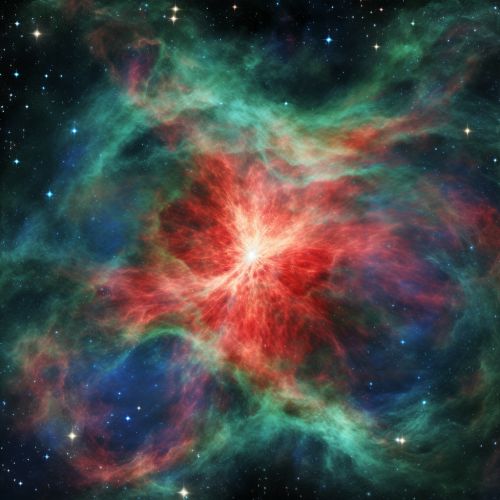Supernova Remnant
Introduction
A supernova remnant (SNR) is the structure resulting from the explosion of a star in a supernova. The supernova remnant is bounded by an expanding shock wave, and consists of ejected material expanding from the explosion, and the interstellar material it sweeps up and shocks along the way.


Formation
Supernova remnants are formed when the outward pressure of a supernova explosion overcomes the star's gravitational pull, causing the star's outer layers to be thrown off in a violent explosion. This material, composed of the star's outer layers and the nuclear fusion products from the star's lifetime, then expands into the surrounding interstellar medium, creating a shock wave that sweeps up an expanding shell of gas and dust, which is observed as a supernova remnant.
Structure
The structure of a supernova remnant can be divided into three main parts: the free expansion phase, the Sedov-Taylor phase, and the snowplow phase.
Free Expansion Phase
The free expansion phase is the initial stage of a supernova remnant's life. During this phase, the material ejected by the supernova moves outward into space at a constant velocity, sweeping up the surrounding interstellar medium.
Sedov-Taylor Phase
The Sedov-Taylor phase, also known as the adiabatic phase, begins when the mass of the swept-up interstellar medium is equal to the mass of the ejected material. In this phase, the expansion slows down, and the supernova remnant begins to cool and thin out.
Snowplow Phase
The snowplow phase, also known as the radiative phase, begins when the supernova remnant has cooled enough that the shocked interstellar medium can radiate away its heat. In this phase, the expansion of the supernova remnant slows down even more, and it begins to fade from view.
Observations
Supernova remnants can be observed at many different wavelengths of light, including radio, optical, X-ray, and gamma-ray. Each of these wavelengths reveals different aspects of the supernova remnant and its environment.
Radio Observations
Radio observations of supernova remnants can reveal the presence of high-energy electrons spiraling around magnetic field lines, a process known as synchrotron radiation. This can provide information about the magnetic fields within the supernova remnant, as well as the energy of the electrons.
Optical Observations
Optical observations can reveal the presence of ionized gas in the supernova remnant. This can provide information about the composition of the supernova remnant, as well as the temperature and density of the gas.
X-ray Observations
X-ray observations can reveal the presence of very hot gas in the supernova remnant. This can provide information about the shock wave that is driving the expansion of the supernova remnant, as well as the temperature and density of the gas.
Gamma-ray Observations
Gamma-ray observations can reveal the presence of very high-energy particles in the supernova remnant. These particles can be produced by the shock wave, and their presence can provide information about the energy of the shock wave and the magnetic fields within the supernova remnant.
Supernova Remnants and the Interstellar Medium
Supernova remnants play a crucial role in the evolution of the interstellar medium. The shock waves from supernova remnants can trigger the formation of new stars, and the supernova remnants themselves can provide a source of heavy elements, which are necessary for the formation of planets and life.
